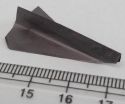Next-gen melanoma drug, TAK-733, excels in lab tests
2014-11-11
(Press-News.org) A University of Colorado Cancer Center study published online this week in the journal Molecular Cancer Therapeutics reports anti-cancer activity in 10 out of 11 patient tumor samples grown in mice and treated with the experimental drug TAK-733, a small molecule inhibitor of MEK1/2. While the drug is conceived as a second-generation inhibitor in patients harboring the BRAF mutation, the study shows drug activity in melanoma models regardless of BRAF mutation status. Treated tumors shrunk up to 100 percent.
"The importance of this molecule is that it's a next-generation and highly potent inhibitor of a known melanoma pathway. It was highly effective against melanoma and the method of our study - using patient-derived tumor samples grown in mice - makes us especially optimistic that we should see similar results in the human disease," says John Tentler, PhD, investigator at the CU Cancer Center, associate professor at CU School of Medicine and one of the paper's lead authors.
Between fifty and sixty percent of human melanomas have an activating mutation in the gene BRAF. According to National Cancer Institute statistics, approximately 1 million people in the United States live with melanoma at any given time. In 2011, the U.S. Food and Drug Administration approved the drug vemurafenib to treat BRAF-mutant melanoma. But while response rates to vemurafenib are in the range of 80 percent for patients with the BRAF mutation, the duration of response if frequently limited to between 2 and 18 months.
"We're learning how to use existing drugs better, for example RAF along with MEK inhibitors to block both mutations and thus a common mechanism of resistance. But there is also room for improvement in the drugs themselves and we hope that TAK-733 could improve on the results of existing, approved MEK inhibitors," Tentler says.
Tentler points to the study's use of melanoma samples contributed by human patients and then grown in mice (called "patient-derived xenografts") as a better predictor of the drug's effectiveness in humans. A common alternative to patient-derived xenografts is to grow tumors in mice from cancer cells that have previously been cultured on plastic, sometimes having been derived from patients decades earlier. Previous work at the CU Program for the Evaluation of Targeted Therapy (PETT) lab and elsewhere shows that cultured cells adapt to their plastic environment, over time potentially losing genetic characteristics of the original cancer and also learning to grow in an environment optimized for plastic.
"When you grow cells on plastic and inject them into mice, that's not what a real tumor looks like. Instead, when you take a sample and grow it as a living tumor in a mouse model, you much more faithfully preserve the genetic and tissue landscape characteristics of the original tumor," Tentler says.
Tentler suggests that while approved BRAF inhibitors such as vemurafenib and MEK inhibitors such as trametinib have proved effective in melanoma, TAK-733 may offer substantial enough improvements to justify its continued development.
"There's always a need for better, more potent molecules," Tentler says.
INFORMATION:
ELSE PRESS RELEASES FROM THIS DATE:
2014-11-11
A University of Texas at Arlington physics team is using their expertise in the field of optics and photonics to advance new methods in areas such as mapping the neural circuitry of the brain and guiding neurons to potentially repair damage in the body.
Samarendra Mohanty, an assistant professor of physics, leads the Biophysics and Physiology Lab in the UT Arlington College of Science. He is co-author on two papers published this month. In one published by the online journal PLOS ONE Nov. 10, researchers in Mohanty's lab described using a method called "two-photon optogenetic ...
2014-11-11
Making a paper airplane in school used to mean trouble. Today it signals a promising discovery in materials science research that could help next-generation technology -like wearable energy storage devices- get off the ground. Researchers at Drexel University and Dalian University of Technology in China have chemically engineered a new, electrically conductive nanomaterial that is flexible enough to fold, but strong enough to support many times its own weight. They believe it can be used to improve electrical energy storage, water filtration and radiofrequency shielding ...
2014-11-11
November 11, 2014 - Several lines of research have opened exciting new frontiers in scientific understanding and clinical management of bipolar disorder. Recent advances in bipolar disease research are described in this month's special issue of Harvard Review of Psychiatry. The journal is published by Lippincott Williams & Wilkins, a part of Wolters Kluwer Health.
Bipolar disease is a "prevalent, complex, and hard-to-treat illness [leading] to extreme and erratic shifts of mood, thinking, and behavior, with a very high risk of suicide as well as increased risks of dying ...
2014-11-11
In multiple sclerosis, the immune system goes rogue, improperly attacking the body's own central nervous system. Mobility problems and cognitive impairments may arise as the nerve cells become damaged.
In a new study, researchers from the University of Pennsylvania and co-investigators have identified a key protein that is able to reduce the severity of a disease equivalent to MS in mice. This molecule, Del-1, is the same regulatory protein that has been found to prevent inflammation and bone loss in a mouse model of gum disease.
"We see that two completely different ...
2014-11-11
DALLAS - November 11, 2014 - UT Southwestern Medical Center researchers have determined the specific type of cell that gives rise to large, disfiguring tumors called plexiform neurofibromas, a finding that could lead to new therapies for preventing growth of these tumors.
"This advance provides new insight into the steps that lead to tumor development and suggests ways to develop therapies to prevent neurofibroma formation where none exist today," said Dr. Lu Le, Assistant Professor of Dermatology at UT Southwestern and senior author of the study, published online and ...
2014-11-11
As scientists probe the molecular underpinnings of why some people are prone to obesity and some to leanness, they are discovering that weight maintenance is more complicated than the old "calories in, calories out" adage.
A team of researchers led by the University of Pennsylvania School of Veterinary Medicine's Kendra K. Bence have now drawn connections between known regulators of body mass, pointing to possible treatments for obesity and metabolic disorders.
Their work also presents intriguing clues that these same molecular pathways may play a role in learning ...
2014-11-11
Salivary mucins, key components of mucus, actively protect the teeth from the cariogenic bacterium, Streptococcus mutans, according to research published ahead of print in Applied and Environmental Microbiology. The research suggests that bolstering native defenses might be a better way to fight dental caries than relying on exogenous materials, such as sealants and fluoride treatment, says first author Erica Shapiro Frenkel, of Harvard University, Cambridge, MA.
S. mutans attaches to teeth using sticky polymers that it produces, eventually forming a biofilm, a protected ...
2014-11-11
From this week's Eos: Scientists Engage With the Public During Lava Flow Threat
On 27 June, lava from Kīlauea, an active volcano on the island of Hawai`i, began flowing to the northeast, threatening the residents in Pāhoa, a community in the District of Puna, as well as the only highway accessible to this area. Scientists from the U.S. Geological Survey's Hawaiian Volcano Observatory (HVO) and the Hawai`i County Civil Defense have been monitoring the volcano's lava flow and communicating with affected residents through public meetings since 24 August. Eos recently ...
2014-11-11
The majority of people - including healthcare professionals - are unable to visually identify whether a person is a healthy weight, overweight or obese according to research by psychologists at the University of Liverpool.
Researchers from the University's Institute of Psychology, Health and Society asked participants to look at photographs of male models and categorise whether they were a healthy weight, overweight or obese according to World Health Organisation (WHO) Body Mass Index (BMI) guidelines.
They found that the majority of participants were unable to correctly ...
2014-11-11
CHAMPAIGN, Ill. -- Tiny, thin microtubes could provide a scaffold for neuron cultures to grow so that researchers can study neural networks, their growth and repair, yielding insights into treatment for degenerative neurological conditions or restoring nerve connections after injury.
Researchers at the University of Illinois at Urbana-Champaign and the University of Wisconsin-Madison created the microtube platform to study neuron growth. They posit that the microtubes could one day be implanted like stents to promote neuron regrowth at injury sites or to treat disease.
"This ...
LAST 30 PRESS RELEASES:
[Press-News.org] Next-gen melanoma drug, TAK-733, excels in lab tests






